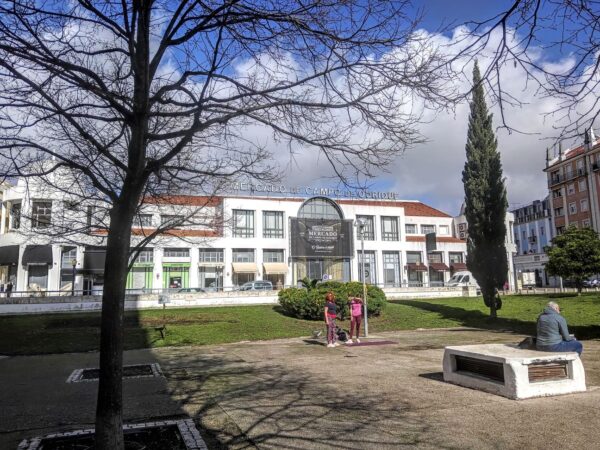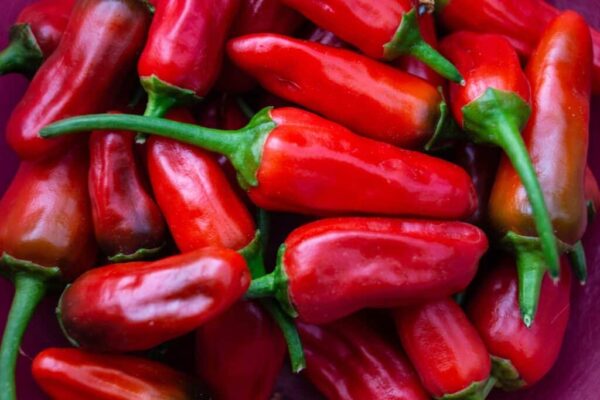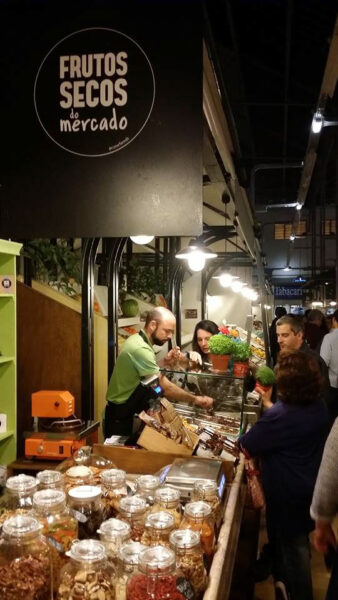Heart of the market
When we arrived at our next destination the Mercado de Campo de Ourique a mere 300 meters away from Pastelaria Chikapa, I was still trying to clean the custard off my vest and would spend much of our visit there continuing that process. Thus, I leaned even more heavily on K’s notes for this post than I did for some of the others and I’ll always give credit where credit is due.

(If you’re wondering, Campo de Ourique means Field of Ourique and it represents the defining moment in establishing the nation of Portugal. It was at the Battle of Ourique near present day Castro Verde in the Alentejo that Dom Afonso Enriques and his army defeated the five Moorish kings of Seville, Badajoz, Elvas, Évora, and Beja and those forces then reportedly declared him the first king of Portugal on 25 July 1139.
There’s also a Portuguese idiomatic expression “resvés Campo de Ourique” that roughly translates as “by a hair’s breadth.” I’ve mentioned previously that the Portuguese use the 1755 earthquake as a historical dividing point. Much of the old city of Lisboa was destroyed by the temblor itself, the tsunami it triggered, or the fires that followed. Although Estrela, the neighboring civil parish was mostly devastated by the tsunami, it stopped just short of reaching Campo de Ourique leaving that part of the city more or less intact. Most sources will say that this is the wellspring of this expression. However, as is often the case, an alternative explantion exists. In his book Dicionário de Expressões Correntes, the writer Orlando Neves suggests that the expression might instead be related to the lake of blood that lay in Ourique after the battle between Dom Afonso Henriques and the five Moorish kings.)
Cornu Copiae
Open since 1931, the Mercado de Campo de Ourique is a slightly smaller and possibly less renowned version of the Mercado da Ribeira and Time Out Market in Cais do Sodré. This doesn’t make it any less interesting or less worth visiting. In fact, it’s location and lower notoriety might make it a bit more of an authentic Lisboa experience.
The header for this section is Latin meaning “horn of plenty” and has come into English as the word cornucopia. Although the images we see of a cornucopia rarely include fish and meats, the Mercado de Campo de Ourique is teeming with fishmongers and butchers in addition to the vendors selling fresh fruits and vegetables, frutos secos (dried fruit and nuts), tinned fish, flowers, and baked goods. And, of course, there are stands selling prepared food ranging from pizza to sushi and a recent renovation has created space to sit and eat.
When we entered the market, it seemed as though Ines knew every vendor often greeting them by name. We watched as some of the fishmongers gutted and cleaned the fish and learned that (curiously to me) the Portuguese like to look at a fish’s liver as one way of judging its freshness. (I was taught to look at the eyes which should be clear, look for firm flesh, and usually red gills.)
We made a brief circuit of the market before landing in a small corner shop that K’s notes say was called Bar do Mercado. What we snacked on was sardines tinned with tomatoes served on bread with a home made piri-piri sauce.
The piri-piri tangent
Certain spices such as black pepper, garlic, saffron, paprika and others are common in Mediterranean and Iberian cuisines. If one spice can be said to be unique to Portuguese cuisine it is the African bird’s eye chili pepper or, more colloquially, piri-piri. It looks like this

While they are now cultivated globally and have been a part of far flung cuisines for centuries, peppers have their origin in the Americas. Although the 1494 Treaty of Tordesillas had divided the world between Spain and Portugal – the two great European powers of that time – we know that each traded within the other’s territory so exactly how the botanical fruit (but culinary vegetable) came to Europe is a matter of some dispute.
It’s possible peppers came as early as 1493 when Christopher Columbus returned to Europe after his initial voyage to the Americas with ships bearing captured natives, gold, and, of course, spices. Another possibility is that the Portuguese carried peppers not only to their European homeland but to their colonies in what is today Mozambique and Angola. The African bird’s eye was then developed through a process of cross-pollination. Regardless, it seems clear that piri-piri is the child of the union between mainly Swahili African social culture and Portuguese colonization. I think even if we give Columbus the credit for bringing the pepper east, it was the Portuguese who were primarily responsible for its global dissemination.
While there’s a basic recipe for piri-piri sauce, nearly every restaurant (and probably many home cooks) produce their own sauce with subtle variations. The sauce is common in Portugal and used on many varieties of animal protein from spare ribs to shrimp to chicken and, if you’re already familiar with this pepper it’s almost certainly due to its use on the latter. I suspect it’s also probable that the peri-peri chicken that generated this knowledge comes from at least seeing (if not eating at) Nando’s the multi-national chain that began with its first store in Johannesburg in 1987 but which, given its use of the Galo de Barcelos

in its logo, perhaps ironically, has no stores in Portugal where the dish is traditionally called frango do churrasco or barbeque chicken. (Nando’s uses a variant Romanized spelling of Peri-Peri but it is the same.)
(And now a second chicken diversion. Those of you who read about my trip to South America might recall my obsessive pursuit of pollo a la brasa in Lima. This is another form of spit roasted chicken but it’s somewhat different from Portugal’s piri-piri chicken. After marinating in a soy sauce based mixture the former is cooked whole over wood or charcoal and is further seasoned with variable dry spice rub mixes. Piri-piri chicken is first spatchcocked (butterflied), marinated in a blend that will likely include olive oil, white wine, garlic, bay leaf, lemon juice, piri piri chili peppers and paprika before being salted and cooked on a rotating spit over flaming hot coals. Pollo a la brasa is served with a variety of sauces that range from a mayonnaise based mild sauce to chimichurri to some flamingly hot red and green sauces. Piri-piri comes only with the eponymous pepper sauce.)
And he fed her fruit and nuts
It’s probably fair to say that when most Americans think of dried fruits, the image that comes to mind is one of fleshy fruits such as bananas, apricots, grapes, or plums that have been naturally or synthetically dried. We don’t particularly think of nuts and seeds as dried fruits. However, according to the U.S. Forest Service,
Nuts are actually fruits. They are defined as dry, single-seeded fruits that have high oil content. They are usually enclosed in a leathery or solid outer layer. In botany terms, nuts are strictly a particular kind of dry fruit that has a single seed, a hard shell, and a protective husk. Chestnuts, hazelnuts, pecans, and walnuts fit the true definition of a nut. Peanuts and almonds do not meet the botanical definition of a true nut. Peanuts are actually legumes and a fleshy coat like a plum surrounds almonds. Whether they are true “nuts” or not, people throughout the world enjoy these fruits.
Thus, when you see the term frutos secos (literally ‘dried fruits’) describing a shop in Portugal you can expect to find both fleshy dried fruit and nuts at a minimum. Our final eating stop in the Mercado was at Frutos Secos do Mercado aka Prime Seeds.

Here we sampled the full range of their specialty amêndoas carmelizadas (carmelized almonds) ranging from cinnamon to salted flower, to ginger and, I think our favorite, lime. We also tasted chocolate macadamia nuts, cashews with chocolate and a few others. Both K & P and I took home small bags of the lime coated almonds and I added a jar of doce de abóbora or pumpkin jam that became my go to sweetener to complement some of the sharp cheese I’d eat later in my stay.
But so far, all we’ve had would prove to be mere appetizers. Now it was time to have lunch.
Kudos, Todd, your posts have succeeded in revving up the gastric juices! Lovely descriptions, enticing photos, and fascinating information abound, as usual, in your wonderful posts. Thank you!
You’re welcome. And thanks for reading!
I have four more flavorful (I hope) food related posts to come.